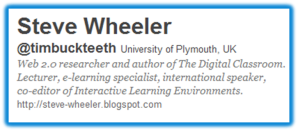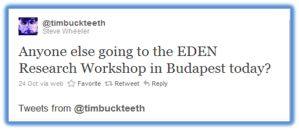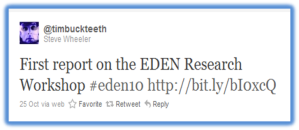I have to say that I enjoyed reading Chapter 7: Student Activities in the Online Environment and got quite excited by the long list of student activities that Ko and Rossen provide:
- role playing and simulations
- summaries and consensus groups
- experience-based practicum or lab assignment
- reflective activities
- just discussion
- scenarios and case studies
- peer editing and review
- peer activities involving guest speakers
- cross cultural exchanges
- using the web as a resource
I know I was only expected to read as far as “Reflective Activities”, but I got carried away.
The chapter was also very good in providing solid advice for organising, supervising and assessing group activities. I’m particularly interested to learn how to facilitate effective group activities that prove to be satisfying for all concerned. In my experience of group work, there’s usually some element that doesn’t sit right for someone. Ko and Rossen advocate that it’s “best for the instructor to play a role in dividing students into groups” (p.176) and they further advocate that the online tutor provide some level of supervision to the group. This is to “encourage participation by all group members and ensure that an individual’s contributions to the group are recognized” (p.179).
I recall reading an article earlier in the course, which explained that the key to successful group work is to “design tasks that are truly collaborative, meaning the students will benefit more from doing the activity as a group than doing it alone”. Now, if only I could locate that article…
Continuing on, it was recommended that this week’s post might be about our experiences trying one of the tools for students’ activities, Diigo for example.
I would categorise Diigo as a social bookmarking tool, but the official blurb insists that it’s so much more:
- A Personal Research Tool
- A Collaborative Research Platform
- A Social Content Site
- A Knowledge-Sharing Community
Although I’m not new to social bookmarking, I’ve only recently become a user of Diigo. I previously started using Delicious, but my bookmarks got wiped out when they were taken over by… heaven knows who. So I’ve just started all over again, but this time with Diigo, and with a few lessons learnt. I use Diigo as my primary social bookmark service and have it automatically export my bookmarks to Delicious, so I now have a backup in case something similar happens again. This is one of the potential pitfalls of using proprietary platforms on the open web. It’s great whilst its working, but you need to have a back up plan for your data if things go wrong. Indeed, only last week Diigo suffered some kind of hacker-attack and the site was down or subverted for a while.
Diigo has the potential to be used not only for bookmarking (social or not), but also for group work by students. This might include peer editing and review activities or indeed facilitating summary and consensus group activities.
Eureka! I just found that article: how to design effective online group work activities.
References:
Bart, M. (2010) How to Design Effective Online Group Work Activities. Available at:http://www.facultyfocus.com/articles/online-education/how-to-design-effective-online-group-work-activities/




